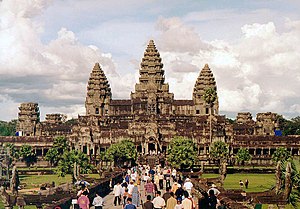Siamese-Cambodian War 1831–1834
| date | 1831 to 1834 |
|---|---|
| place | Cambodia , South Vietnam and Eastern Laos |
| Casus Belli | During a period of unrest in Cambodia, Siam sought to regain sovereignty over the country |
| output | Cambodia became a vassal of Vietnam |
| consequences | In the further course of the history of Southeast Asia, Siam had to forego the areas of the old Khmer Empire entirely in favor of Vietnam as part of French Indochina |
| Parties to the conflict | |
|---|---|
|
|
Cambodia |
| Commander | |
|
King Rama III. (ruled 1824-1851) of Siam |
Ang Chan II (r. 1791 to 1835) |
| Troop strength | |
| at least 15,000 soldiers on the side of Vietnam | |
The Siamese-Cambodian War of 1831-1834 was the last major military conflict between Siam and Cambodia .
prehistory
As early as the beginning of the 17th century, Vietnam had been involved in the affairs of the Khmer , who tried to break free from the clutches of the Siamese of Ayutthaya and sought help from the Vietnamese. By the end of the 18th century, the conflict between Siam and Vietnam turned into an open power struggle for supremacy in Cambodia. Before the rebellion of 1811/12, its king Ang Chan II (ruled 1791 to 1835) had paid tribute to both neighbors, as was tradition. However, this did not help him when his brother turned to Siam for help and King Rama II (ruled 1809 to 1824) helped him to ascend the throne. Ang Chan was able to regain the throne a little later with the help of the Vietnamese, but only at the price of vassal status to Vietnam.
course
In 1831 King Rama III decided. (ruled 1824 to 1851) to bring Cambodia back under Siamese sovereignty and ordered the invasion. He dispatched troops that marched from north to south. Ang Chan was defeated in the Battle of Kompong Chang in 1832 and had to retreat to Vietnam again. In pursuit of him, Siamese troops also advanced into South Vietnam and took the cities of Châu Đốc and Vinh-long before being forced to retreat by a larger Vietnamese army. In the meantime, a general uprising began against the Siamese rulers in Cambodia and eastern Laos. Vietnam took advantage of the current weakness of the occupiers and moved to Cambodia with an army of around 15,000 men, put Ang Chan back on the throne in Udong and drove the Siamese from the Khmer empire.
consequences
Cambodia was permanently withdrawn from the direct influence of Siam, especially after it was incorporated into French Indochina .
See also
Individual evidence
- ↑ Phillips and Axelrod (2004), pp. 1039f.
literature
- Charles Phillips and Alan Axelrod: Encyclopedia of Wars . 3 Vols. New York: Facts on File 2004. ISBN 9780816028511 .
- WAR Wood : A History of Siam: from the earliest times to the year Ad 1781, with a supplement dealing with more recent events . New York: AMS 1974.
